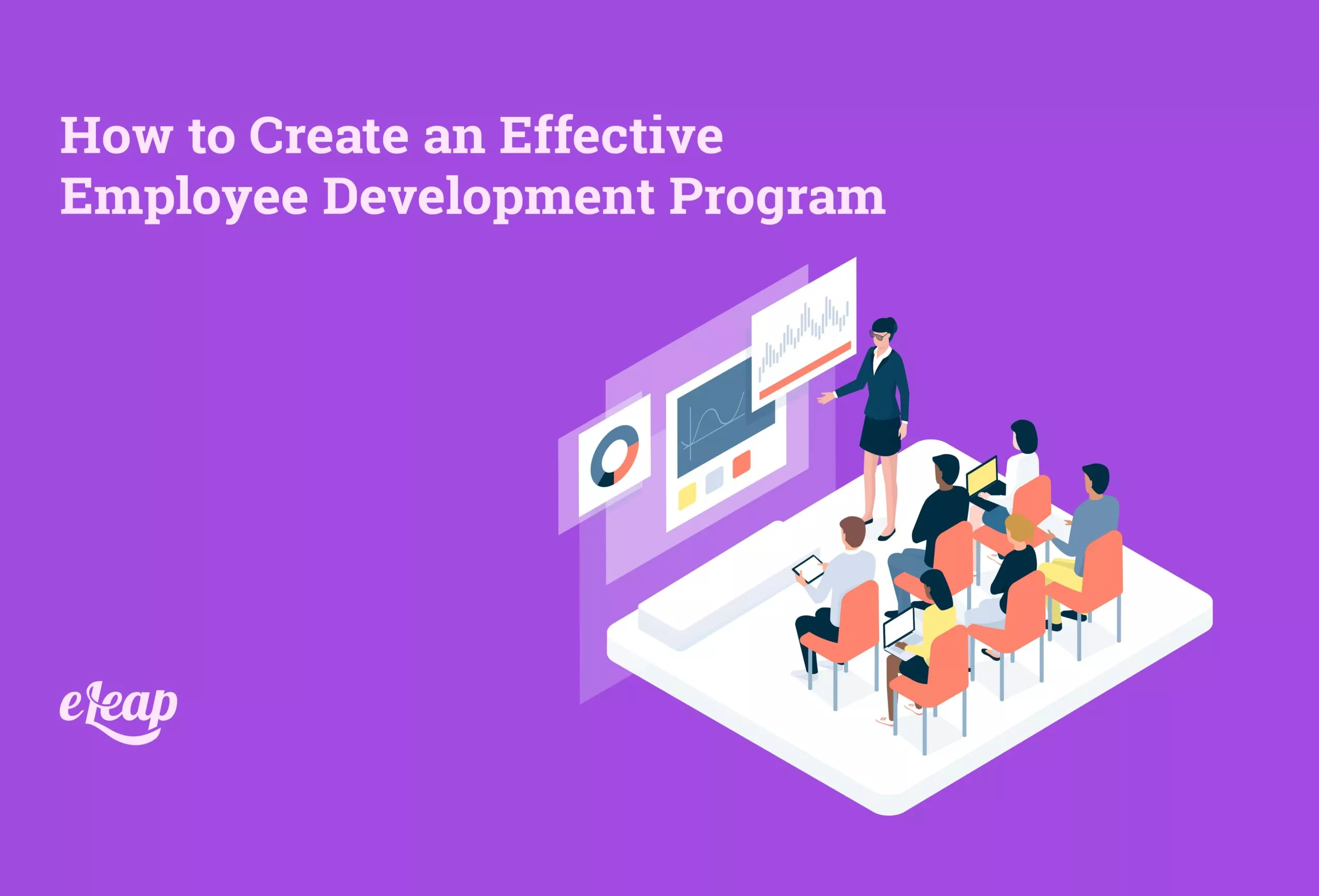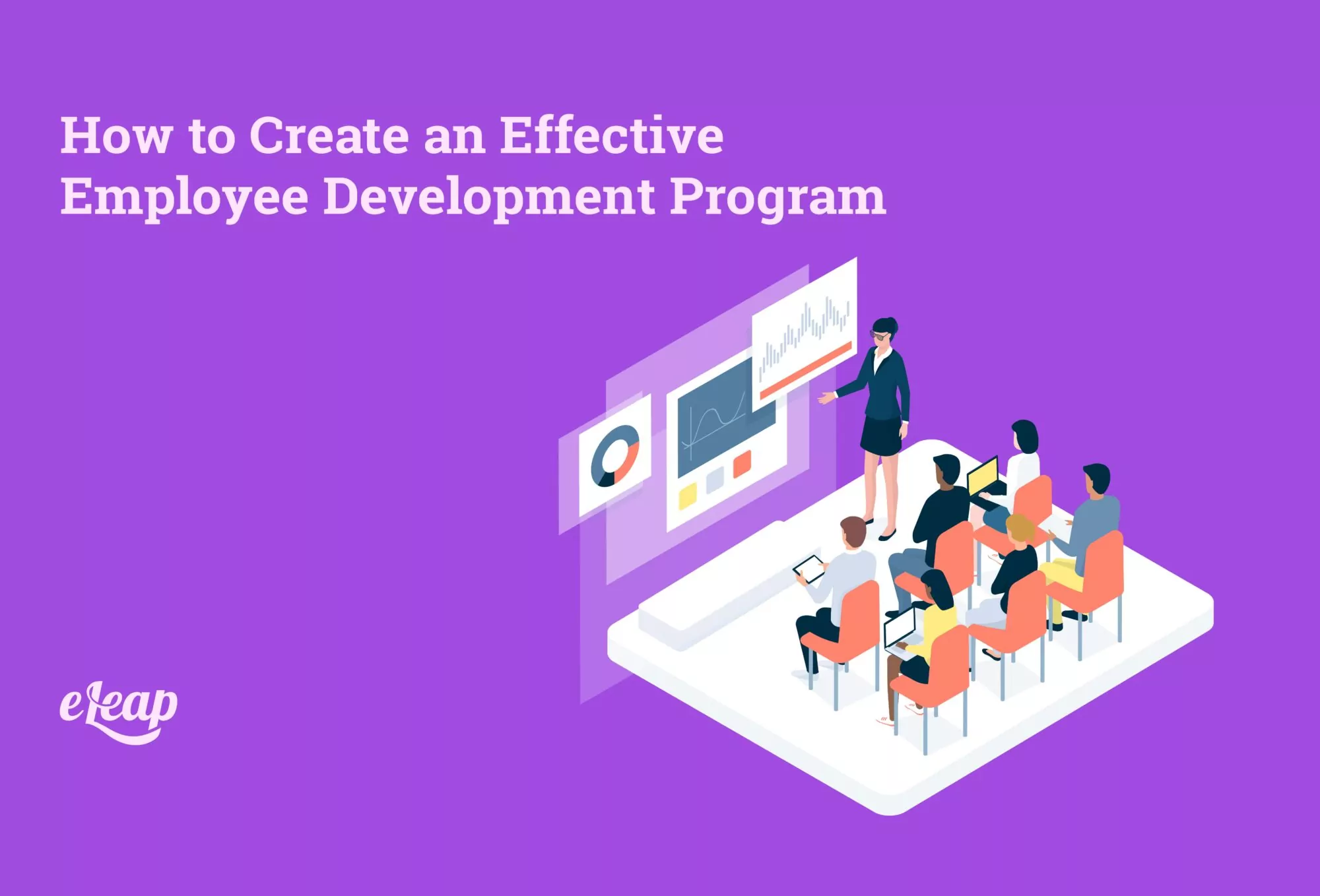How to Create an Effective Employee Development Program

Employee development is one of the most critical factors in creating a motivated, skilled, and engaged workforce. Employee development programs help employees grow their skills, knowledge, and competencies to perform better in their current roles and prepare them for future responsibilities. A robust employee development program can significantly impact employee satisfaction, retention, and productivity, all contributing to a business’s long-term success. Explore how eLeaP®’s Performance Management Platform can simplify evaluations, boost productivity, and drive measurable results.
This article will explore the essential components of creating an effective employee development program, how to align it with your company’s goals, and the steps you can take to ensure its success. Whether starting from scratch or looking to refine an existing program, these strategies will help your organization build a solid framework for employee growth.
What is an Employee Development Program?
An Employee Development Program is a strategic initiative to improve employees’ skills, knowledge, and capabilities through structured learning and development activities. These programs enhance employees’ abilities to perform their jobs effectively and prepare them for future organizational roles.
Employee development is more than just training. It encompasses mentorship programs, job rotation, coaching, and access to resources facilitating continuous learning. It is an investment in human capital that helps employees realize their potential while contributing to the organization’s objectives.
When designed effectively, an employee development program can increase employee engagement, reduce turnover, and foster a culture of continuous improvement.
Why Employee Development Programs are Crucial for Businesses

Investing in employee development is not just about providing opportunities for employees to learn new skills—it’s about positioning your organization for long-term success. Employee development programs bring substantial benefits to both employees and the organization.
Employee Retention
One of the most compelling reasons businesses should invest in employee development is retention. According to a Gallup report, 87% of millennials believe development is essential to their jobs. Employees who feel supported and valued through development opportunities are likelier to stay with the company. When employees feel that their skills are being nurtured and have a clear path for advancement, they are likelier to remain engaged and loyal to the organization.
Increased Productivity and Performance
Employee development programs help employees enhance their skills and become more proficient. This stage leads to greater efficiency and productivity. Employees who are more confident in their abilities can make better decisions, solve problems more effectively, and contribute to the company’s overall success.
Furthermore, continuous development ensures that employees are updated with industry trends and best practices, improving performance over time.
Enhancing Organizational Agility
Organizations must be agile to stay competitive in today’s rapidly changing business landscape. Employee development plays a vital role in enhancing organizational agility. By offering training and development opportunities that build diverse skills, businesses create a workforce that can adapt to new challenges and changes. For example, allowing employees to learn new technologies, processes, or leadership skills helps prepare them to take on new responsibilities as the business evolves.
Employee Satisfaction and Engagement
Engaged employees are more productive and committed to their roles. Employee development programs contribute significantly to employee satisfaction by showing employees that their growth is essential to the organization. Offering training opportunities, coaching, and access to resources gives employees a sense of investment in their future, which drives job satisfaction and engagement. Motivated and engaged employees are likelier to go above and beyond, improving overall organizational performance.
Key Components of an Effective Employee Development Program
An effective employee development program has several key components, each contributing to its success. These components ensure that the program meets the needs of both the organization and the individual employees.
Aligning Development Programs with Organizational Goals
An effective employee development program must align with the organization’s strategic goals. This alignment ensures that the skills and competencies employees gain through development directly apply to the company’s objectives. For example, if a company’s strategy is focused on digital transformation, the development program should include training on digital tools, data analytics, or technology management.
When the development program aligns with the organization’s goals, employees understand the larger purpose behind their learning. This step helps them see how their growth contributes to the company’s success. Furthermore, this alignment helps the company build a more skilled workforce, directly contributing to business growth.
Understanding Employee Needs and Career Aspirations
Each employee has different developmental needs, career aspirations, and learning preferences. An effective program takes these individual differences into account. To tailor the program, HR professionals can conduct one-on-one interviews, surveys, and performance reviews to understand better employees’ strengths, areas for improvement, and career goals.
By deepening their understanding of employees’ aspirations, businesses can design personalized development plans that align with their goals and the organization’s objectives. For example, if an employee aspires to take on a leadership role, the development program can include leadership training, mentoring, and cross-functional team projects.
Setting Clear, Measurable Objectives
To gauge the success of the employee development program, it’s essential to set clear, measurable objectives. These goals should be specific, realistic, and time-bound. For example, if the program aims to improve sales skills, the objective could be to increase the number of successful sales calls by 15% within three months after the training.
Employees and managers can track progress and make necessary adjustments by setting clear goals. This process helps ensure that the program is effective and that employees continue to grow.
Offering Tailored Learning Opportunities
A one-size-fits-all approach does not work when it comes to employee development. Employees learn differently, offering various learning opportunities can help meet their needs. These include formal training sessions, e-learning courses, on-the-job training, peer-to-peer mentoring, and coaching.
For example, eLeaP is a powerful Learning Management System (LMS) that offers customizable learning pathways. This process allows organizations to provide personalized training for employees’ needs. By offering a mix of formal and informal learning opportunities, companies ensure that employees can engage with the content in ways that resonate most with them.
Building a Culture of Continuous Learning
An effective employee development program doesn’t stop at a single training session. Creating a culture of continuous learning where development is an ongoing process is essential. A company that prioritizes learning fosters an environment where employees are motivated to improve, try new things, and share knowledge with their peers. This culture encourages employees to take ownership of their professional growth, contributing to a more dynamic and forward-thinking workplace.
Managers can support this culture by recognizing employees’ achievements, offering regular feedback, and providing resources for self-directed learning. Encouraging employees to participate in external training or attend industry conferences can broaden their perspectives and keep them engaged.
Steps to Building an Effective Employee Development Program
Now that we’ve covered the key components of an employee development program let’s take a closer look at the steps you can take to build one that meets the needs of your business and employees.
Step 1: Conduct a Thorough Needs Assessment
Before developing any program, you must understand the needs of both the organization and the employees. Start by assessing the skills gaps within the company—where are the weaknesses, and where does the company need additional capabilities to meet its goals?
You can perform a needs assessment by conducting employee surveys, reviewing performance appraisals, and analyzing business goals. This information will help you determine the required key skills and competencies and guide you in designing a program that addresses these gaps.
Step 2: Define the Program’s Scope and Structure
Once the needs assessment is complete, the next step is to define the program’s scope and structure. Decide whether the program will be company-wide or targeted at specific departments or teams. Will it be an ongoing or a short-term initiative?
The structure should include the learning opportunities, such as classroom training, online courses, coaching, and mentoring. You should also determine the delivery format: Will training be delivered in person, through webinars, or via an e-learning platform like eLeaP?
Step 3: Set Clear and Achievable Development Goals
Once you’ve defined the scope, it’s time to set clear and achievable goals for the program. These goals should align with the business’s needs and the employees’ aspirations. Whether the goal is to improve leadership skills, enhance technical capabilities, or increase employee engagement, having measurable goals will help track the program’s success.
These goals must be SMART (Specific, Measurable, Achievable, Relevant, Time-bound), as this framework will help you measure progress and ensure that the program is effective.
Step 4: Implement the Right Tools and Resources
You will need the right tools and resources to implement your employee development program successfully. Learning management systems (LMS), such as eLeaP, are essential for delivering online courses, tracking progress, and measuring outcomes. You can also incorporate workshops, coaching, mentoring, and job rotations to ensure a balanced approach to employee development.
Ensure that the resources are accessible to all employees and that they can easily track their progress. Transparency helps maintain motivation and engagement.
Step 5: Foster Ongoing Support and Feedback
Support and feedback are crucial for the program’s success. Employees need to feel that they are being supported throughout their development journey. Managers should regularly check in with employees to offer feedback on their progress, encourage, and identify areas for improvement.
Having a mentorship program where employees are paired with senior colleagues can also provide them with valuable guidance. Feedback should be constructive and focused on helping employees improve.
Step 6: Measure Program Effectiveness and Make Adjustments
Once the program runs, it’s essential to measure its effectiveness regularly. This step can be done through surveys, performance metrics, and tracking key performance indicators (KPIs) like employee retention rates, productivity levels, and engagement scores.
If certain aspects of the program aren’t achieving the desired results, be prepared to make adjustments. Continuous evaluation and iteration ensure that the program remains relevant and valuable.
Best Practices for Employee Development Programs
Several best practices should be considered to ensure the success of your program. These practices will help you maintain a high level of engagement and ensure that employees get the most out of their development experience.
Regular Check-ins and Feedback Mechanisms
Regular check-ins and feedback are essential for keeping employees on track. These meetings help identify any obstacles the employee might face and provide an opportunity to realign the program if needed.
Cross-Functional Collaboration and Knowledge Sharing
Encouraging collaboration between different teams or departments helps employees broaden their skills and knowledge. Cross-functional projects allow employees to work in new areas and gain experience in various aspects of the business.
Promote Career Advancement Opportunities
Employees are more likely to stay engaged if they see a clear pathway for career advancement. Offering leadership training, mentoring, and opportunities for promotion within the development program can help retain top talent.
Leverage Technology for Remote Learning
With remote work on the rise, providing flexible learning opportunities is crucial. Using an e-learning platform like eLeaP ensures that employees can access training materials and courses wherever they are, enabling them to grow their skills at their own pace.
Conclusion
An Employee Development Program is a powerful tool for improving employee performance, enhancing job satisfaction, and aligning the workforce with the organization’s long-term goals. By designing a comprehensive, personalized, and aligned program with business objectives, you can create an environment where employees feel valued, engaged, and motivated to grow.
The key to success lies in continuous improvement—both for the employees and the program itself. By measuring progress, gathering feedback, and making adjustments, you ensure that the development program remains relevant and effective in driving employee success and organizational growth.